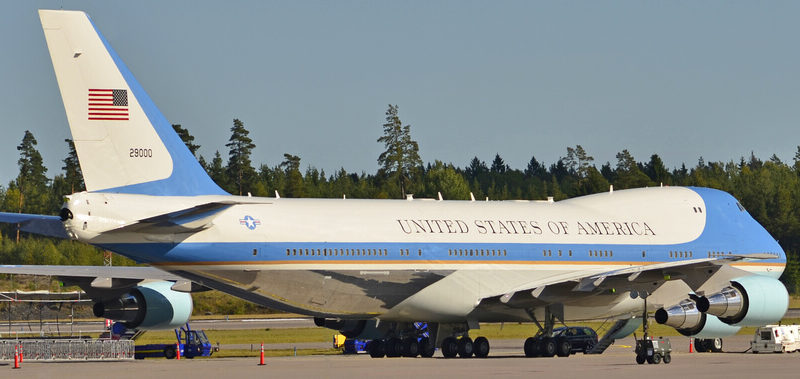This article was originally published on AeroTime News on August 23, 2019.
Just recently, the United States Air Force chose between two viable contestants to replace the VC-25A – surprisingly, the Airbus A380 and the home favorite, Boeing 747-8. Ultimately, and probably to nobody’s huge surprise, the Air Force chose the 747 – on January 28, 2015, the service branch officially announced their decision, designated the program as the VC-25B and set the deadline for Boeing to deliver the new Air Force One aircraft in 2024. The final price of the two new 747s is set to be at $3.9 billion.
The new Air Force One will continue the dynasty of Boeing jets serving the United States president. But that dynasty almost came to an end when the time came to replace the two aging VC-137C, which served as Air Force One aircraft since 1962.
On August 23, 1990, the United States Air Force officially accepted the first out of two new Air Force One aircraft – a modified Boeing 747-200B, specifically catered to the needs of the United States president. The Queen captured the throne and Boeing delivered two VC-25A to the Air Force, tail numbers 28000 and 29000.
This is the story of how, with the VC-25A, Boeing almost lost the spot to its competitors.
Unlikely contenders
Back in 1985, during Ronald Reagan’s term, the 707 were already aging – while the tail number 26000 Boeing 707 was just over 20 years old and tail number 27000 just hit 13 years of service, the technology used on both jets was outdated. Thus, the United States Air Force began to look for options to replace the VC-137C.
A United States Air Force spokesman, Maj. Michael Perini said that the Air Force is looking “to replace both aircraft [VC-137C – ed. note] by late 1988” and that the branch has sent out “request for proposals” towards various aircraft manufacturers. The basic requirements were that the jet was a commercial airliner and had “at least two years’ operational service with a scheduled airline”. Three front runners emerged – Boeing with the 747-200B, McDonnell Douglas with the DC-10-30 and Lockheed with the L-1011 TriStar. Airbus had no place at the competition at that time – the only possible option was the A310, but even then the twin-engine did not have enough range to have a chance.
Comparing the three aircraft models, Lockheed was very far behind the other two. Lockheed’s TriStar was smaller in cabin width and overall length. In addition, a questionable reliability record due to the problems with its Rolls-Royce engines put the L-1011’s entry into jeopardy.
McDonnell Douglas had a huge advantage – the United States Air Force operated the KC-10 Extender, military transport and mid-air refueling aircraft, thus it had an abundance of spare parts and experience, including maintenance procedures, of using the jet. The DC-10 would have saved a lot of money for the United States taxpayer.
What Boeing lacked in operating costs, the Queen more than made up in other specifications – the 747-200B had more range and was bigger in every aspect than the other two.
Sealing the deal
But the specifications laid out by the United States Air Force indicated that the aircraft needed to be brand spanking new. This was the final straw for Lockheed, as the manufacturer just ended the production of the TriStar in 1984, a year before the U.S.A.F. decided to replace the 707.
Both Lockheed and McDonnell Douglas had another issue – the Air Force wanted a quad jet, rather than a trijet. Jeff Rhodes, a Communications Specialist at Lockheed Martin recalled that the “Air Force called for a four-engined aircraft”. Even then, Lockheed did not give up, even if their only entry did not completely fit the requirements. The company had a few TriStars “with relatively few flying hours” that could be refurbished to compete for the Air Force One spot. Lockheed, while knowing that they were unlikely to win it, decided not to “concede the playing field to the Boeing 747 without some effort on our part”.
And as mentioned before, the Air Force already operated a military variant of the DC-10, the KC-10 Extender. While it would have saved costs, the DC-10 carried a huge elephant in the fuselage – its reputation. With three high profile crashes during the 1970s, the flying public was not very fond of the aircraft, which even had several nicknames depicting its tendency to crash. Picking the DC-10 to carry the president around the world would have potentially resulted in a PR nightmare, which McDonnell Douglas itself failed to resolve when the FAA grounded the DC-10 in 1979.
Thus, the winner was clear and Boeing 747-200B claimed the throne to be the Air Force One. The deal was sealed in June 1986. Both the United States Air Force and Boeing indicated that the first aircraft would be delivered in November 1988, with the second VC-25A coming in May 1989. If all went according to plan, Ronald Reagan would still be able to fly on the newest Air Force One, as his term was scheduled to end in January 1989.
Unfortunately, Boeing ran into severe delays. After initially delaying the first delivery of the VC-25A to January 1989, the American manufacturer pushed the delivery further to January 1990, due to issues while installing specialized communications equipment onboard.
This meant that Reagan never had a chance to ride on the newest 747 as a president, as Boeing finally handed over the VC-25A on August 23, 1990, almost two years after the initial plan.

